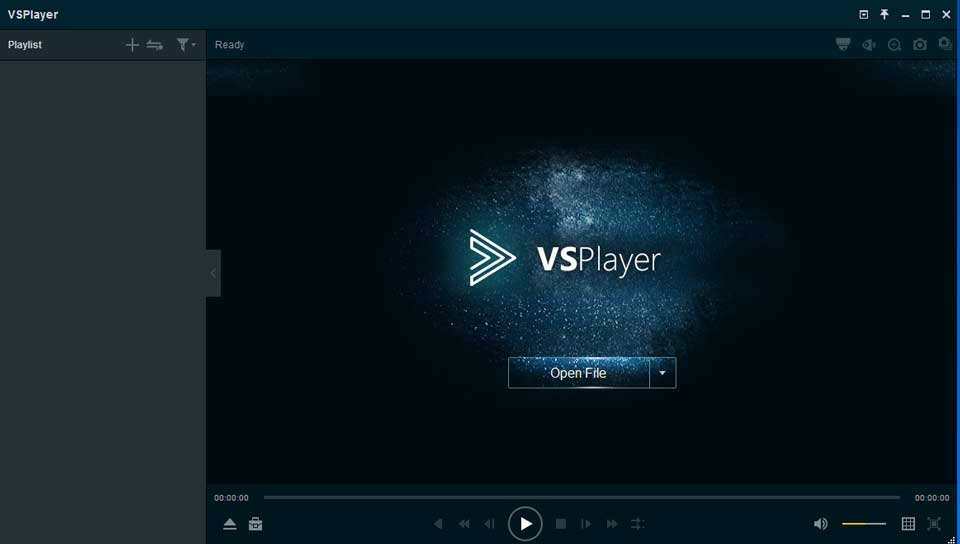VSPlayer Software User Manual, The VSPlayer software is a media player designed for Windows OS. With user-friendly GUI, the software provides an intuitive, convenient way for playing media file and video control, and supports multiple audio and video formats.
The VSPlayer software is a media player designed for Windows OS. With user-friendly GUI, the software provides an intuitive, convenient way for playing media file and video control, and supports multiple audio and video formats.
V7.3
Added New Features:
- RTMP protocol for media streaming.
- View the live video of device via HLS protocol.
- Display picture, temperature and fire source information on the display window.
- Support hardware decoding for live view.
- Convert the video files from H.265 format to other formats.
- The VCA information does not display when starting playing the video by default.
V7.2
Added New Features:
- Support fisheye expansion for playing video files of fisheye camera.
- Support setting the location modes including by timestamp and by frame in basic settings.
- Support media streaming to share the local video file, live view of device, and desktop to
others in the same LAN.
V7.1
Added New Features:
- Filter the files by file name or accurate time, and locate the video by accurate time.
- New UI for video clipping and file format converting.
- The user manual is packaged into the software.
- Optimize the digital zoom, audio control and repeat A-B segment function.
V7.0.0
- Support playing the video files of the various kinds of devices, such as DVR, encoder, decoder, compression card, network camera, network speed dome, etc.
- Support multiple video file formats, including Hikvision H.264, standard H.264 and standard MPEG4.
- Support 1, 4, 9, 16-window division.
- Multiple languages GUI are provided.
- Capture pictures and continuous capture during playing.
- Get the file information.
- Support file clipping, file merging and file converting.
- Support watermark.
- Digital zoom.
- Accurately position the playback point by frame or time.
- Synchronous playback.
- Reverse playback.
- Display the VCA information on the video.
- Support playing encrypted file.
- Repeat between the configured two points.
- Live view via URL mode with RTSP.
- Support motion flow to provide fluent video.
Operating System: Microsoft Windows XP (32 / 64-bit) / Windows 7 (32 / 64-bit) / Windows 8
(32 / 64-bit) / Windows 10 (32 / 64-bit)
RAM: 2GB or above
In order to simplify the description, we define the “VSPlayer software” as “software” in the following chapters.
After installing the software, click on the desktop to run the software.
The main interface of the software is shown below. For the descriptions of the icons and buttons on the interface, please refer to Table 2.1 Main Interface Introduction.
Note: You can click to change the language of the software.
VSPlayer Software User Manual
Read more :
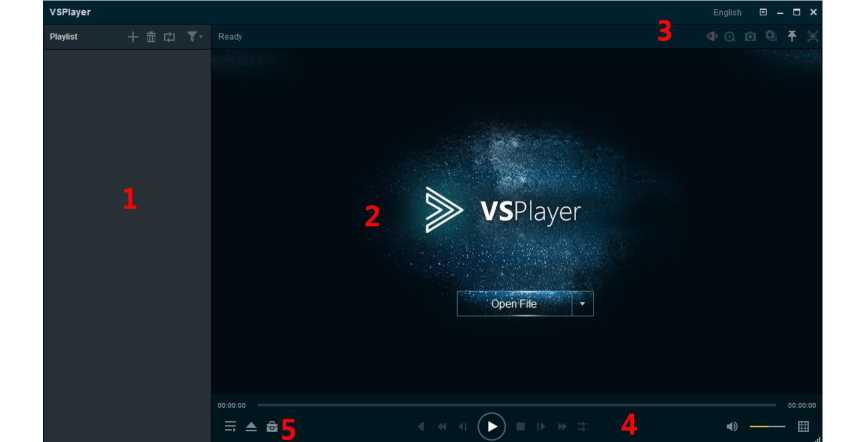
Table 2.1 Main Interface Introduction
| No. | Icon/Button | Description |
| 1 | Add the local media file to the software. | |
| Eni | Delete the added files. | |
| w | Set the playing mode for the file. | |
| EB | Filter the added files by file name or accurate time. | |
| 2 | Display window area. You can click Open File to select the file for playing. | |
| 3 | Select file, set language, configure player settings, view the user manual and check the software information. | |
| o | Minimize the software. | |
| H | Maximize the software. | |
| s | Exit the software. | |
| Fisheye expansion. | ||
| [ol | Digital zoom. | |
| Capture the playing video. | ||
| [•J | Continuous capture of the playing video. |
| Click and select whether to keep the window on top of all other windows. | ||
| ■ | Display the playing window in full-screen mode. | |
| 4 | □ | Reverse play. |
| □ | Slow forward. | |
| a | Frame backward. | |
| emb | Play / pause the video. | |
| □ | Stop playing. | |
| ID | Frame forward. | |
| ID | Fast forward. | |
| Ei | Synchronous playback. | |
| Audio on / mute. | ||
| Set window-division. | ||
| 5 | Hide the playlist. | |
| □ | Open files, open directory or open live view via URL mode. | |
| Fil | Activate the window of clip, convert, merge or streaming. |
Click @ and select Settings, or select Settings on the right-click menu of the playing window to enter the Player Settings interface. You can set basic, capture and hotkey settings for the player.
Player Settings X
>t (pj &
Basic
Stick on Top:
O Stick on Top When Playing
@ Never Stick on Top
O Always Stick on Top
Locate by:
O Locate by Timestamp
@ Locate by Frame
[✓ Save List File When Exit
| | Hardware Decoding for Live View Restore
OK Cancel Apply
Steps:
- Click Basic to enter the Basic Settings interface.
- Set the option for Stick on Top.
Stick on Top When Playing: Keep the window on the top of all other windows when playing
the file.
Never Stick on Top: Never keep the windon on the top of all other windows at any time.
Always Stick on Top: Always keep the windon on the top of all other windows.
- Set the location method during playing.
By Timestamp: Click on the timeline to locate the image according to the timestamp.
By Frame: Click on the timeline to locate the image according to the frame.
- Check Save List File When Exit checkbox to keep the playlist when you exit and you can get the playlist next time you open the software.
- (Optional) Check Hardware Decoding for Live View checkbox to enable decoding by hardware for live view.
It provides better decoding performance and lower CPU usage.
- You can also click Restore to reset the parameters to the default values.
- Click Apply to apply the settings. Or click OK to save the settings and exit.
Player Settings X
X t§) (w)
Basic Capture Hotkey
Stick on Top:
O Stick on Top When Playing
® Never Stick on Top
O Always Stick on Top
Locate by:
O Locate by Timestamp
® Locate by Frame
0 Save List File When Exit
| | Hardware Decoding for Live View Restore
OK Cancel Apply
Steps:
- Click Capture to enter the Capture Settings interface.
- Select the Format for the captured picture.
- Click Browse to set the saving path for captured pictures.
- Set the continuous capture.
Mode: Select the mode as by time / by frame.
Interval: Set the time / frame interval in the range of 1 to 100 seconds / frames.
Max. Capture Number: Configure the maximum capture number in the range of 1 to 200.
- You can also click Restore to reset the parameters to the default values.
- Click Apply to apply the settings. Or click OK to save the settings and exit.
Player Settings X
>t O (^)
Basic Capture Hotkey
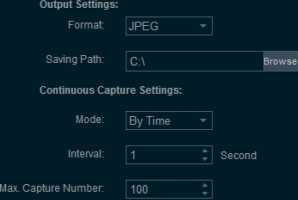
Restore
OK Cancel Apply
Steps:
Click Hotkey to enter the Hotkey Settings interface.
1.
2.
3.
4.
You can view the keyboard hotkeys for the common functions of the software.
Click the text field, and you can change the hotkey as desired.
You can also click Restore to reset the parameters to the default values.
Click Apply to apply the settings. Or click OK to save the settings and exit.
| Player Settings
X Basic |
Capture | |WWi|
Hotkey |
X | |
| Open File: | Ctrl+Q | Fast Forward: | | Ctrl+Right | |
| Open Directory: | Ctrl+D | Slow Forward: | | Ctrl+Left | |
| Open URL: | Ctrl+U | ] Restore Normal Speed: | | Ctrl+R | |
| Play/Pause: | | Space | Last Frame: | | Ctrl+J | |
| Stop: | Ctrl+S | First Frame: | | Ctrl+K | |
| Frame Forward: | 1 Right | Capture: | | F11 | |
| Frame Backward: | i Left | Nomal/Full Screen: | Ctrl+F | |
| Volume +: | 1 up | RepeatA-B Segment | Ctrl+C | |
| Volume -: | | Down | Exit | Ctrl+W | |
| Fisheye Expansion: | Ctrl+P | Restore | ||
| OK | 1 Cancel | Apply | ||
Before you start:
You should add the supported media file to the playlist of the software.
The software provides two ways for adding the local video files, including adding files of the selected folder and adding files directly. And you can also open live view of device via URL mode.
Adding Files
Steps:
- Click ES in the playlist area, or click Open File on the playing window, or click = and select Open File, or click @ and select Open File under Open.
Note: The Open File on the playing window is only available when no video is playing and the window-division is 1.
- In the pop-up window, select the file for adding.
You can also hold Shift or Ctrl key to select multiple files.
Adding Folders
Steps:
- Click il besides Open File on the playing window and select Open Directory, or click = and select Open Directory, or click [n] and select Open Directory under Open.
- In the pop-up window, select a folder for adding.
You can add the supported files under the folders to the software.
URL Mode
Steps:
- Click il besides Open File on the playing window and select Open URL, or click = and select Open URL, or click S and select Open URL under Open.
- In the pop-up window, input the URL of the video.
Note: Only RTSP and HLS protocol are supported for URL mode.
• For RTSP protocol, Format: rtsp://admin:12345@172.10.7.157/Stream/Channels/101. admin: The user name of the camera.
12345: The password to log in to the camera.
172.10.7.157: The IP address of the camera.
101: The main stream of camera 01.
• For HLS protocol, Format: http://10.20.37.12:9086/8ch06la25569d.m3u8.
You can generate the HLS URL when creating network media streaming task. For details, refer to Chapter 3.8 Media Streaming.
You should select the connection mode according to actual needs.
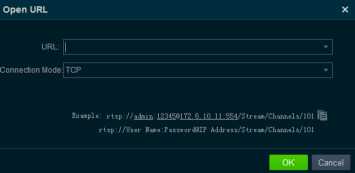
Right-click the file in the Playlist and the following items are available on the right-click menu. For details, refer to Table 3.1 Right-Click Menu on Playlist Description.
Note: The right-click menu varies according to different file types.
Table 3.1 Right-Click Menu on Playlist Description
| Name | Description |
| Play/Pause | Play/pause the file. |
| Delete File | Delete the selected file(s) from the software. |
| Remove Invalid File | Delete the all the invalid file of the playlist. The invalid files are marked with Invalid. |
| Clear Playlist | Delete all the files of the playlist. |
| File Location | Open the folder of the file. |
| Enter Key | Enter the key of the file which is encrypted. |
After adding the video files to the playlist, you can play the file and achieve the related functions to control the video playing.
The successfully added files list on the playlist panel and you can drag the file to the display window or double-click it for playing.
Note: For the encrypted files, you should enter the key in the pop-up window to play it.
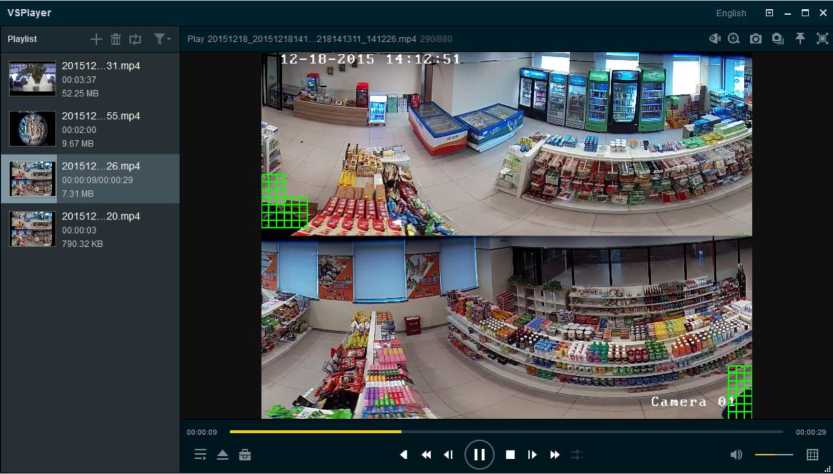
You can control the video playing by clicking the provided icons. For details, refer to Table 3.2 Playing Control.
Table 3.2 Playing Control
| Icon | Description |
| H | Set the playing mode for the file as single, order, repeat one or repeat all. |
| E9 | Select to filter the files by file name or accurate time. Filtering by accurate time can search the video files of the configured time point. |
| □ | Play the video reversely.
Note: It is not available for the live view which accessing via URL mode or after hardware decoding enabled. |
| □ | Set playback speed as 1/2, 1/4, 1/8 or 1/16.
Note: It is not available for the live view which accessing via URL mode or after hardware decoding enabled. |
| ED | Enable reverse playback frame by frame. Click it once to go backward by one frame.
Note: It is not available for the live view which accessing via URL mode or after hardware decoding enabled. |
| sun | Play or pause the video. |
| □ | Stop playing. |
| ID | Enable playback frame by frame. Click it once to go forward by one frame.
Note: It is not available for the live view which accessing via URL mode or after hardware decoding enabled. |
| □ | Set the playback speed as 2X, 4X, 8X or 16X.
Note: It is not available for the live view which accessing via URL mode or after hardware decoding enabled. |
| E3 | Start synchronous play under multi-window mode. The files for synchronous play should have overlapped time duration. Refer to Chapter 3.3 Synchronous Playback for details.
Note: It is not available for the live view which accessing via URL mode or after hardware decoding enabled. |
| EEl/E | Turn off/on the audio. Drag the slider bar to adjust the volume. You can also press the Up or Down key on your keyboard to increase or decrease the volume. You can increase the volume up to 200%. |
| Set window division as 1*1, 2*2, 3*3 or 4*4. You can select a window and double-click a video file to play it. See the above figure with multi-window division. | |
| © | Enable digital zoom. Use the mouse to draw a yellow rectangle and the image within it will be enlarged. A navigation window will show and you can drag the yellow rectangle to adjust its position. Click the icon again to disable digital zoom.
You can also use the mouse wheel to zoom in or zoom out. |
| El | Capture the playing video. Refer to Chapter 3.4 Capture and Continuous Capture for details. |
| a | Start continuous capture of the playing video. Refer to Chapter 3.4 Capture and Continuous Capture for details.
Note: It is not available after hardware decoding enabled. |
| Select whether to keep the window on top of all other windows. | |
| Display the playing window in full-screen mode. |
Or you can right-click on the playing window to access the play control menu. For details, refer to Table 3.3 Right-Click Menu on Display Window Description.
Note: By default, VCA information does not display when starting playing the video.
Full Screen
Stick on Top ►
Play Control ►
Play Mode ►
Mute
Image Control ►
Aspect Ratio ►
Window Division ►
Capture
Continuous Capture
Digital Zoom
Clip
Convert
Merge
Media Streaming
Fisheye Expansion
Settings
File Information
Table 3.3 Right-Click Menu on Display Window Description
| Name | Description | |
| Full Screen | Display the playing window in full-screen mode. | |
| Stick on Top | Stick on Top When Playing | Select whether to keep the window on the top of all other windows |
| Never Stick on Top | ||
| Always Stick on Top | ||
| Play Control | Locate by Timestamp: Input the time and the video will be played back from that time.
Locate by Frame: Accurately position the playback point by frame. Locate by Accurate Time: Locating by accurate time to play back the video of the configured time point. First Frame: Go to the first frame of the video. Last Frame: Go to the last frame of the video. Drop Frame: Drop the frame to reduce the CPU usage. Motion Flow: Enable the function to get the fluent video, especially for motion image. |
|
| Repeat A-B Segment: Click to enable this function, and drag the A and B point on the timeline to adjust the position. Then the video can repeat between the configured two points.
For other items, please refer to the description of the related icons. |
||
| Play Mode | Set the playing mode for the file as single, order, repeat one or repeat all. | |
| Mute | Turn off the audio of the file. | |
| Image Control | Image Rotation | Rotate the image during playing. |
| Color Adjustment | Set the parameters of saturation, hue, contrast and brightness | |
| Watermark | Check the watermark information of the video. | |
| VCA Info. | VCA: Display the VCA information.
Note: You should configure the VCA information for the live view which accessing via URL mode. For details, refer to the User Manual of the device. |
|
| Motion Detection: Highlight the motion of the video.
Note: You should configure the motion detection for the live view which accessing via URL mode. For details, refer to the User Manual of the device. |
||
| POS Text Overlay: Display the POS text.
Note: This function should be supported by the device and the device should be configured with POS text overlay. For details, please refer to the User Manual of the device. |
||
| Temperature: Display the detected
temperature. Note: This function is only available for thermal camera. For details, refer to the User Manual of the thermal camera. |
||
| Picture Overlay: Display the picture on the display window.
Note: You should configure the picture information for the live view which accessing via URL mode. For details, refer to the User Manual of the camera. |
||
| Fire Source: Display the file source information. Note: This function is only available for thermal camera. For details, refer to the User Manual of the thermal camera. | ||
| Aspect Ratio | Set the video size as original size, 4:3, 16:9 or Fill Window. You can also set the window size as 2X, original size, 1/2 or 1/4. | |
| Window Division | Set the 1/49/16-window division. | |
| Capture | Capture the playing video. Refer to Chapter 3.4 Capture and Continuous Capture for details. |
| Continuous
Capture |
Continuous capture of the playing video. Refer to Chapter 3.4 Capture and Continuous Capture for details.
Note: It is not available after hardware decoding enabled. |
| Digital Zoom | Enable digital zoom of the video. |
| Clip | Clip the file to get the required video footage. Refer to Chapter 3.5 Clipping the File for details.
Note: It is not available for the live view which accessing via URL mode or after hardware decoding enabled. |
| Convert | You can convert the files or real-time streams to other format. Refer to Chapter 3.6 Converting the File for detailed configuration. |
| Merge | Merge multiple files (>=2) into a single large file. Refer to Chapter 3.7 Merging the Files for details. |
| Media
Streaming |
Create local, network, or desktop media streaming and generate URL to share the videos to other computers and devices in the same LAN. Refer to Chapter 3.8 Media Streaming. |
| Fisheye
Expansion |
Play the video files in fisheye expansion mode. Refer to Chapter 3.9 Fisheye Expansion.
Note: It is not available for the live view which accessing via URL mode or after hardware decoding enabled. |
| Settings | Configure the player settings, including basic, capture and hotkey settings. Please refer to Chapter 2.2 Player Settings for detailed information. |
| File Information | Check the detailed information of the file, such as file name, video length, file size, file type and resolution, etc. |
Purpose:
You can play the video files in synchronization if they have overlapped time duration.
Note: This function is not available for the live view which accessing via URL mode or after hardware decoding enabled.
Steps:
- Click [RS and select a multi-window (2×2, 3×3 or 4X4) division.
- Select a window and double-click a video file to play it.
- Repeat step 2 to start playing multiple video files.
- Click El to start synchronous play.
Note: The files for synchronous play should have overlapped time duration.
- (Optional) You can drag the *1 to zoom in or zoom out the timeline bar.
Click LI to adjust the playback position.
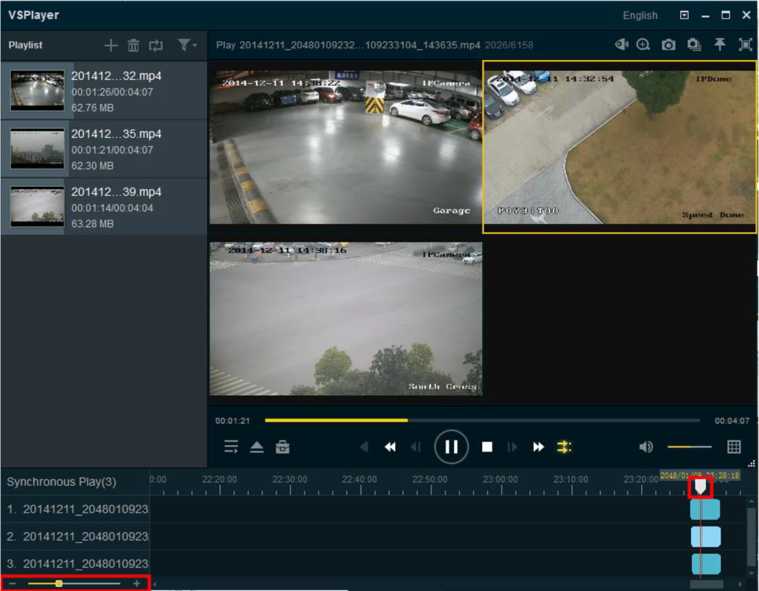
You can take pictures of the playing video and save them to local PC.
There are two ways available for capturing pictures, including Capture and Continuous Capture.
Capture: During the video playing, click O to take a picture for the video. Refer to Chapter 2.2.2 Capture Settings for the saving path and picture format of the captured pictures.
Continuous Capture: During the video playing, click E! to start continuous capture of the playing video to take pictures continuously. You can click O to stop the continuous capture manually. Otherwise, the continuous capture stops after the number of captured pictures has reached the configured maximum capture number. Refer to Chapter 2.2.2 Capture Settings for the saving path of the captured pictures and the related parameters.
Note: Continuous capture is not supported after hardware decoding enabled.
Purpose:
During playback, you can clip the file to get the required video footage.
Note: This function is not available for the live view which accessing via URL mode or after hardware decoding enabled.
Steps:
- During the video playing, click ts! and select 1^3, or select Clip on the right-click menu of
the playing window to enter the Clip interface.
Note: For selecting Clip under E, you should click Open File, or click □ to select a video file for clipping.
- Drag Q to set the desired start and end position of the video footage. You can also click 0 and D to adjust the position.
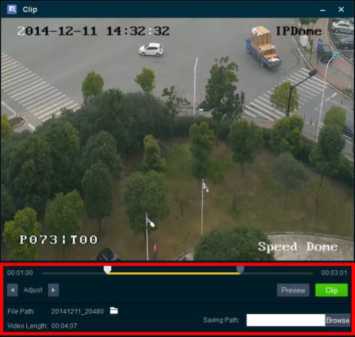
- (Optional) You can click Preview to view the video to clip.
- Click Browse to set a saving path and file name for the clipped file.
- Click Clip to clip the file.
Purpose:
You can convert the files or real-time streams to the target formats, and the parameters are configurable, such as format, encoding type, resolution, bitrate, and so on.
Steps:
- Click and select , or select Convert on the right-click menu of the playing window to
pop up the Format Converter window.
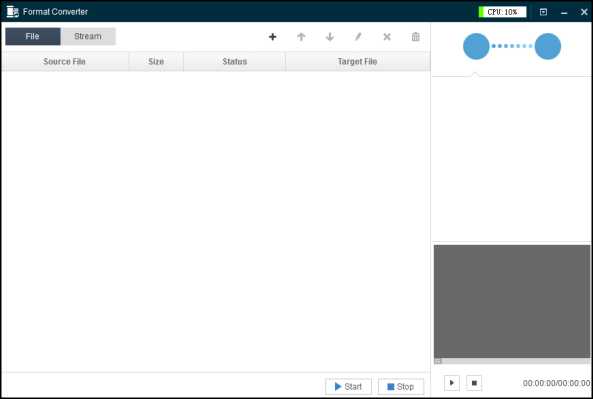
- Add file(s) or real-time streams.
- For adding file(s), select File tab, click + and select Single Add to add one file, or click
Batch Add to add files in batch.
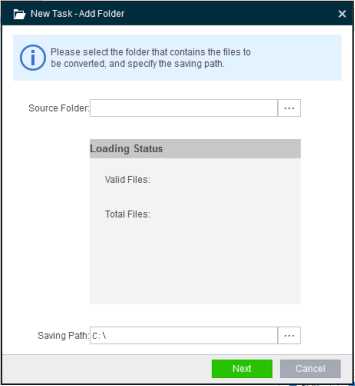
- For adding real-time stream, select Stream tab and click + to add the real-time stream.
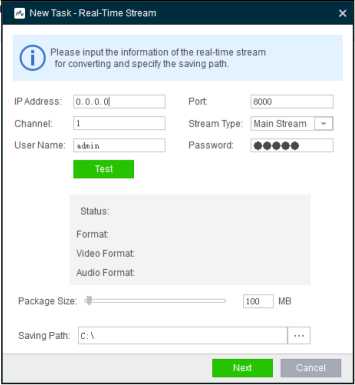
For detailed configuration about format converting, please refer to the user manual of the Format Converter (click © and select User Manual on the Format Converter window).
Note: You can convert the video files from H.265 format to other formats, but converting video files from the other formats to H.265 is not supported.
Purpose:
You can merge multiple files into a single large file to view all the needed files continuously.
Note: This function is not supported by the live view which accessing via URL mode.
Steps:
- Click and select , or select Merge on the right-click menu of the playing window to
enter the Merge interface.
- Click Add to select the files from local PC.
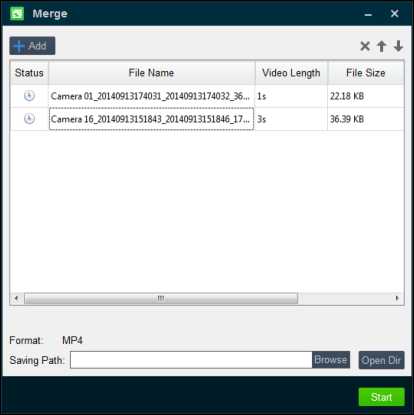
- (Optional) Click to select a file and click t or I to move the file up or down to adjust its merging position.
You can also click x to remove it from the merging list
- Click Browse to set a saving path and file name for the merged file.
You can click Open Dir. to open the directory.
You can click Stop during the merging process.
Purpose:
You can create local, network, or desktop media streaming task and generate URL to share the videos of local files, live view of device, or desktop to other users in the same LAN.
Steps:
- Right-click on the display window area and select Media Streaming to open the Media Streaming tool.
Or you can click E°1 and select S to open the Media Streaming tool.
Note: The Media Streaming tool should keep running during the whole process of media streaming.
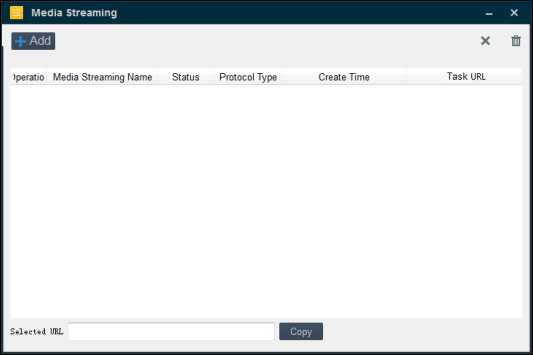
- Click Add button and select the media streaming type as Local, Network, or Desktop.
• Local: Share the local video/audio file to others
For creating the media streaming of local video/audio files:
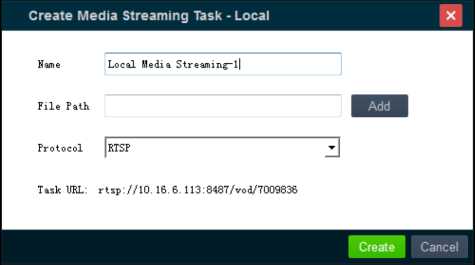
- Input the media streaming name in the Name field as you want.
- Click Add button to browse and select the video/audio file from local PC.
- Select the protocol type as RTSP, HLS or RTMP.
Note: Table 3.4 Supported Encoding Format shows the supported video/audio file encoding formats under RTSP, HLS and RTMP protocol.
Table 3.4 Supported Encoding Format
| Protocol
Package'”^. Format |
RTSP | HLS | RTMP |
| PS | Video: H.264, H.265;
Audio: G711a, G711u, G722, AAC, MPEG; |
Video: H.264;
Audio: AAC; |
Video: H.264;
Audio: G711a, G711u, AAC; |
| RTP | Video: H.264, H.265;
Audio: G711a, G711u, G722, AAC; |
Video: H.264;
Audio: AAC; |
Video: H.264;
Audio: G711a, G711u, AAC; |
| TS | Video: H.264;
Audio: G711a, G711u, G722, AAC |
Video: H.264;
Audio: AAC; |
Video: H.264;
Audio: G711a, G711u, AAC; |
(4) Click Create to create the task and generate the media streaming URL.
• Network: Share the live view of the device to others
For creating the media streaming of live view of device:

- Input the media streaming name in the Name field as you want.
- In the Source URL field, input the address of the device.
Note: The source URL should be a valid URL address with user name, password of the device and the corresponding protocol.
For example, the source URL can be:
rtsp://10.16.6.113:8487/live/ubp2195t78674q6
- Select the protocol type as RTSP, HLS or RTMP.
Note: Table 3.4 Supported Encoding Format shows the supported video/audio file encoding formats under RTSP, HLS or RTMP protocol.
- Click Create to create the task and generate the media streaming URL.
• Desktop: Share the live image of the desktop to others
For creating the media streaming of the current desktop:
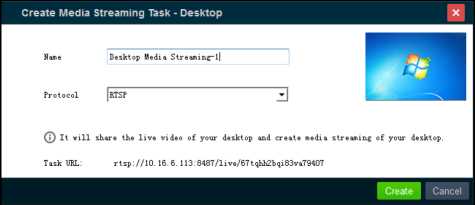
- Input the media streaming name in the Name field as you want.
- Select the protocol type as RTSP, HLS or RTMP.
Note: Table 3.4 Supported Encoding Format shows the supported video/audio file encoding formats under RTSP, HLS or RTMP protocol.
- Click Create to create the task and generate the media streaming URL.
The created task with details, including name, status, protocol type, create time and URL, will display in the media streaming list as follows.
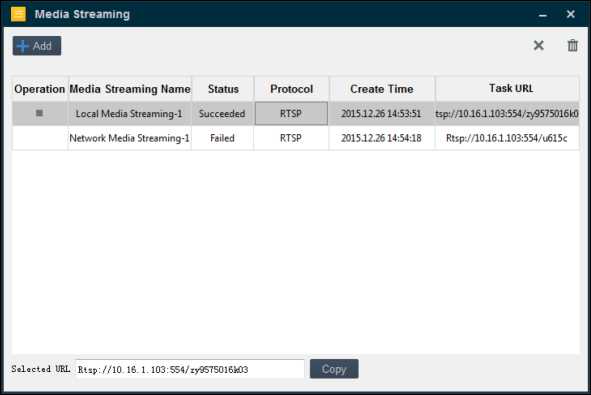
- (Optional) Select the task and click to delete it. Or you can right-click on the target task
and select Delete to delete it.
- (Optional) Select the task and click ® to clear all the tasks. Or you can right-click on the task and select Clear to clear all the tasks.
- (Optional) Select the media streaming task with status as Succeeded and click Copy button to copy its URL. Or you can right-click the target task and select Copy to copy the URL.
You can send the URL to others to share the local video, the live view of the device, or the desktop view. Other users can open the URL with the player which supports media streaming function to view the shared video.
Purpose:
You can play the fisheye camera’s video files in fisheye expansion mode.
When playing the video files of the fisheye camera, you can click O button to enter the Fisheye Expansion interface. Or you can right-click on the display window area and select Fisheye Expansion to enter the Fisheye Expansion interface.
Notes:
- This function is not available for the live view which accessing via URL mode or after hardware decoding enabled.
- The video files should be larger than 4K.
- Start playing the video file by VSPlayer before fisheye expansion.
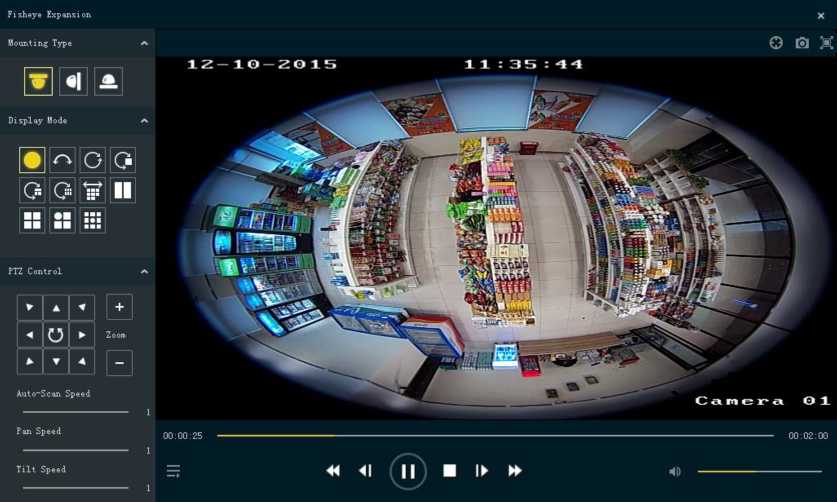
For the introductions of play control buttons, pleases refer to Table 3.2 Playing Control.
Steps:
- Select the mounting type.
Select ceiling mounting, wall mounting, or table mounting according to the actual mounting
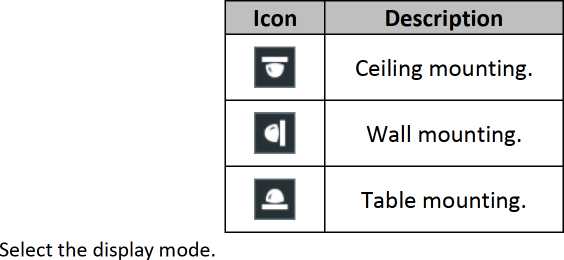
2.
type you adopted for your camera.
You can select a display mode for the layout of the live view window. The description of each display mode is shown in the following table.
| Icon | Description |
| □ | Fisheye view. |
| Panorama view. | |
| e | Panorama view and 3 PTZ views. |
| IS | Panorama view and 8 PTZ views. |
| 4 PTZ views. | |
| One fisheye view and 8 PTZ views. | |
| Panorama view and 3 PTZ views for wall mounting. |
| Icon | Description |
| Dual-180 o panorama view. | |
| Panorama view and one PTZ view. | |
| E | Panorama view and 6 PTZ views. |
| □ | 2 PTZ views. |
| One fisheye view and 3 PTZ views. | |
| n | Panorama view for wall mounting. |
| Ei | Panorama view and 8 PTZ views. |
• Fisheye View: In the Fisheye view mode, the whole wide-angle view of the camera displays. This view mode is called Fisheye because it approximates the vision of a fish’s convex eye. The lens produces curvilinear images of a large area, while distorting the perspective and angles of objects in the image.
Fisheye View
• Panorama/Dual-180o Panorama View: In the Panorama view mode, the distorted
fisheye image is transformed to normal perspective image by some calibration methods.
Panorama View
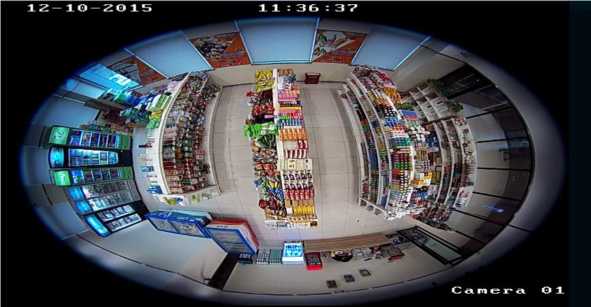
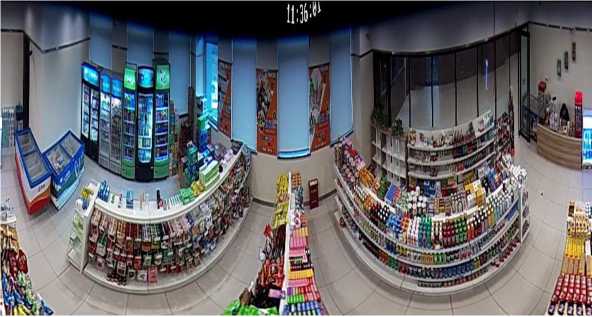
Dual-180o Panorama View
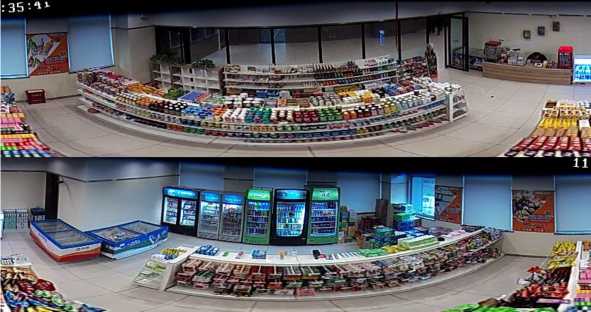
• PTZ View: The PTZ view is the close-up view of some defined area in the Fisheye view or Panorama view, and it supports the electronic PTZ function, which is also called e-PTZ.
Note: Each PTZ view is marked on the Fisheye view and Panorama view with a specific navigation area with different colors. You can drag the navigation area on the Fisheye view or Panorama view to adjust the PTZ view, or drag the PTZ view to adjust the view
to the desired angle.
Fisheye+3PTZ View
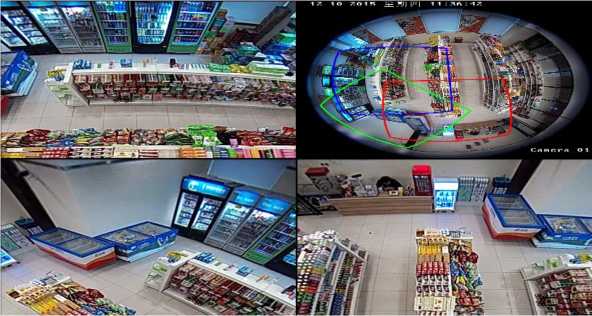
Panorama+3PTZ View

- (Optional) For PTZ view, you can perform the PTZ control in the PTZ Control panel.
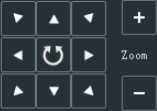 Select the PTZ view, and click the arrow button to adjust the image. You can to zoom in or zoom out the view. You can click Q to start auto-scan.
Select the PTZ view, and click the arrow button to adjust the image. You can to zoom in or zoom out the view. You can click Q to start auto-scan.
PTZ Control
A.uto~Scan Speed.
1
Pan Speed 1
Tilt Speed 1
Or you can drag in the PTZ view and scroll the mouse wheel to realize the PTZ movements.
click D
or
You can also drag the ■ to set the auto-scan speed, pan speed, and tilt speed for better PTZ control.
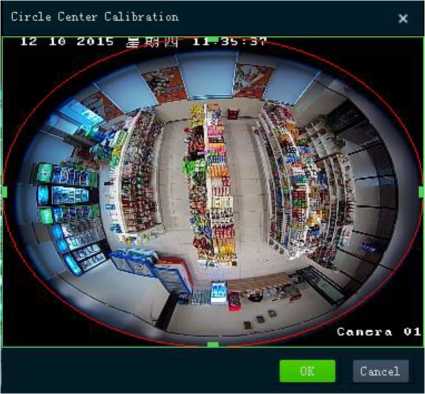 (Optional) Click El to enter the Circle Center Calibration interface to calibrate the circle center of the fisheye and make the fisheye expansion more accurate.
(Optional) Click El to enter the Circle Center Calibration interface to calibrate the circle center of the fisheye and make the fisheye expansion more accurate.- Drag the ■ on the fisheye circle to adjust the red circle close to the fisheye view.
- Click OK to save the calibration.
